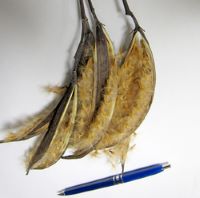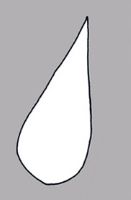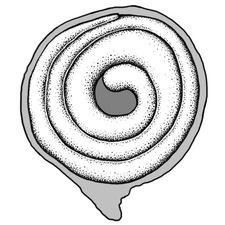Content is from Kirkbride et al. 2006Kirkbride et al. 2006:
Kirkbride JH, Jr, Gunn CR, and Dallwitz MJ. 2006. Family guide for fruits and seeds, vers. 1.0. Accessed September 2020-January 2022. URL: https://nt.ars-grin.gov/seedsfruits/keys/frsdfam/index.cfm ., without modification.
Updates are forthcoming.
Fruits: Pistil(s) simple, or compound; 1; 1-pistillate; with carpels united. Fruit pericarpium, or anthocarpanthocarp:
simple or compound and including some tissue of non-ovarian origin (accessory tissue) ; compound, or schizocarpschizocarp:
; compound, or schizocarpschizocarp:
usually dry fruit splitting between two or more locules to form distinct, indehiscent, usually one seeded segments; fruit derived from a single, superior or inferior, compound ovary; compare to mericarp , or simple; capsulecapsule:
, or simple; capsulecapsule:
a dry, dehiscent fruit derived from a compound ovary , or folliclefollicle:
, or folliclefollicle:
a dry to (rarely) fleshy fruit derived from a single carpel that opens along a single longitudinal suture, derived from a single, superior, simple ovary; the seeds may be arillate or with a fleshy testa (not Spjut), or samarasamara:
(not Spjut), or samarasamara:
a winged, indehiscent, dry fruit containing a single (rarely two) seed(s) (Gilibeea); coccarium (Calli comacoma:
(Gilibeea); coccarium (Calli comacoma:
a tuft of hairs, often attached to the tip of seeds
), or follicarium (Spiraeanthemum); capsiconum (Pancheria); septicidalsepticidal:
type of capsular dehiscence, opening longitudinally by separating between the septa of adjacent carpels
 capsulecapsule:
capsulecapsule:
a dry, dehiscent fruit derived from a compound ovary (Acrophyllum); capsulecapsule:
(Acrophyllum); capsulecapsule:
a dry, dehiscent fruit derived from a compound ovary not inflated; capsulecapsule:
not inflated; capsulecapsule:
a dry, dehiscent fruit derived from a compound ovary without operculumoperculum:
without operculumoperculum:
a dehiscent cap (or lid) of a seed or fruit that opens during germination or dehiscence ; simple; pseudosamara (Aphanopetalum); without persistent central column, or with persistent central column (Cunonia); valves not diverging at top of central column; within accessory organ(s), or not within accessory organ(s); within sepals; persistent, or evanescent; 1-seeded to many-seeded; 1-seeded (to many); with 1(–5)-carpellate (3–5: Goldberg & Cronquist); with carpels united; with carpels remaining united at maturity; with carpels not radiating at maturity; without sterilesterile:
; simple; pseudosamara (Aphanopetalum); without persistent central column, or with persistent central column (Cunonia); valves not diverging at top of central column; within accessory organ(s), or not within accessory organ(s); within sepals; persistent, or evanescent; 1-seeded to many-seeded; 1-seeded (to many); with 1(–5)-carpellate (3–5: Goldberg & Cronquist); with carpels united; with carpels remaining united at maturity; with carpels not radiating at maturity; without sterilesterile:
lacking male and/or female reproductive parts; also, not producing fruit or seed
 carpels; apexapex:
carpels; apexapex:
the point farthest from the point of attachment, or the "tip" of an organ not beaked; dehiscentdehiscent:
not beaked; dehiscentdehiscent:
(v. dehisce) splitting open at maturity to release contents (of a fruit) , or indehiscentindehiscent:
, or indehiscentindehiscent:
not opening on its own, as in a fruit
 . Dehiscentdehiscent:
. Dehiscentdehiscent:
(v. dehisce) splitting open at maturity to release contents (of a fruit) unit seed(s). Dehiscentdehiscent:
unit seed(s). Dehiscentdehiscent:
(v. dehisce) splitting open at maturity to release contents (of a fruit) regularly; at apexapex:
regularly; at apexapex:
the point farthest from the point of attachment, or the "tip" of an organ (assumed); and shedding seeds; without replumreplum:
(assumed); and shedding seeds; without replumreplum:
the rim, formed by the persistent placentas, and connected by a false septum in Brassicaceae fruits. The fruit valves are attached to this rim and separate from it in dehiscent fruits.
. Epicarpepicarp:
outer layer of fruit wall or pericarp, if divided into layers; note here used synonymously with exocarp durable; glabrousglabrous:
durable; glabrousglabrous:
without hairs
, or not glabrousglabrous:
without hairs
(with hairs) (tomentosetomentose:
surface relief—pubescence that is bent and matted, forming a woolly coating; often the hairs are silver or gray-colored ); hairs not glandularglandular:
); hairs not glandularglandular:
surface relief—covered with small, raised secretory glands, regular or irregularly shaped, translucent or opaque, and maybe distinctly colored ; without armature; without wing(s), or with wing(s); 2-winged; with wing(s) laterallateral:
; without armature; without wing(s), or with wing(s); 2-winged; with wing(s) laterallateral:
(of embryo) embryo lies along the side of the seed, generally towards one end; of, at, or from the side; in grasses, can refer to the sides adjacent to the dorsal and ventral sides
(see Gillbeea); without apicalapical:
at or pertaining to the end of the seed or fruit distal from its point of attachment (i.e., base)
respiratory hole. Endocarpendocarp:
the inner layer of the pericarp, if divided into layers present, or absent; not separating from exocarpexocarp:
present, or absent; not separating from exocarpexocarp:
outer layer of fruit wall or pericarp, if divided into layers; note here used synonymously with epicarp ; fibrousfibrous:
; fibrousfibrous:
texture—long, flexible threads, thicker than hairs, that densely cover and obscure the surface , or thin, or woodywoody:
, or thin, or woodywoody:
texture—consisting mainly of indurate lignified tissues, characteristic of or resembling wood
; splitting into 1-seeded pyrenespyrene:
the hard inner portion of a drupe, consisting of a bony endocarp and an enclosed seed
, or not splitting into 1-seeded pyrenes; smooth; without wing; without operculumoperculum:
a dehiscent cap (or lid) of a seed or fruit that opens during germination or dehiscence ; without secretory cavities; without mechanism for seedling escape; without grooves; without longitudinallongitudinal:
; without secretory cavities; without mechanism for seedling escape; without grooves; without longitudinallongitudinal:
of or relating to length or the lengthwise dimension
ridges. Funiculusfuniculus:
(alt. funicle) stalk connecting the ovule (later seed) to the ovary (later fruit) placenta short; short without seed bearing hookswith hooks:
short; short without seed bearing hookswith hooks:
bristles or spines with curved or backwards pointing tips, or with secondary bristles along their length (retinacula); not persisting in fruit after seed shed.
(retinacula); not persisting in fruit after seed shed.
Seeds: Arilaril:
(broad sense) appendicular structure that wholly or partly envelops a seed and is produced from or a modification of the funicle, raphe, or outer integument; usually fleshy or pulpy, sometimes spongy or tufted-capillate, often brightly colored absent. Seed larger than minute; less than 1 mm long to 5 to less than 10 mm long; 0.4–6 mm long; angularangular:
absent. Seed larger than minute; less than 1 mm long to 5 to less than 10 mm long; 0.4–6 mm long; angularangular:
2D shape—having sides that meet at acute or obtuse angles
, or ellipsoidellipsoid:
3D shape—elliptic
, or lanceolatelanceolate:
2D shape—lance-shaped; much longer than wide, with widest point below the middle, tapering to the apex (compare oblanceolate) ; not bowl shaped; not nutlike; without winglike beakbeak:
; not bowl shaped; not nutlike; without winglike beakbeak:
a usually firm, terminal appendage, sometimes tapered ; without caudatecaudate:
; without caudatecaudate:
tapering to a long, tail-like appendage appendage(s); at maturity with food reserves; with endosperm; without canavanine. Sarcotestasarcotesta:
appendage(s); at maturity with food reserves; with endosperm; without canavanine. Sarcotestasarcotesta:
pulpy or fleshy outer layer of the seed coat, simulates aril absent. Testatesta:
absent. Testatesta:
seed coat
 present; with markedly different marginalmarginal:
present; with markedly different marginalmarginal:
at, on, or close to the margin or border
tissue, or without markedly different marginalmarginal:
at, on, or close to the margin or border
tissue; marginalmarginal:
at, on, or close to the margin or border
tissue corklike; without fleshy or leatheryleathery:
texture—moderately thick, tough, and very pliable
layer over hard layer; tight; surface unsmooth, or smooth; surface with discreet raised features, or merged raised features; surface tuberculatetuberculate:
surface relief—bearing small, warty, swelling, rounded, or variously shaped projections , or warted; surface reticulatereticulate:
, or warted; surface reticulatereticulate:
surface relief—netted, raised walls or concave grooves forming a net-like surface pattern with flat, concave, or convex interspaces , or striatestriate:
, or striatestriate:
surface relief—having fine, parallel lines, grooves or ridges ; without crease or line separating cotyledons from hypocotyl-radicle; without notch along margin where cotyledons from hypocotyl-radicle tip approach each other; without glands; without bristles; glabrousglabrous:
; without crease or line separating cotyledons from hypocotyl-radicle; without notch along margin where cotyledons from hypocotyl-radicle tip approach each other; without glands; without bristles; glabrousglabrous:
without hairs
, or pubescentpubescent:
surface relief—bearing hairs
; with hairs over surface, or tuft of hairs at one end (comacoma:
a tuft of hairs, often attached to the tip of seeds
), or tuft of hairs at each end, or hairs along margin; with short hairs; densely hairy; tomentosetomentose:
surface relief—pubescence that is bent and matted, forming a woolly coating; often the hairs are silver or gray-colored ; without agglutinated hairs; without glandularglandular:
; without agglutinated hairs; without glandularglandular:
surface relief—covered with small, raised secretory glands, regular or irregularly shaped, translucent or opaque, and maybe distinctly colored pubescence; without wings, or with wing(s); without collar; without operculumoperculum:
pubescence; without wings, or with wing(s); without collar; without operculumoperculum:
a dehiscent cap (or lid) of a seed or fruit that opens during germination or dehiscence ; colored; monochrome; thin; not becoming mucilaginousmucilaginous:
; colored; monochrome; thin; not becoming mucilaginousmucilaginous:
resembling mucilage; moist and sticky
when wetted; surrounding food reserve. Rapheraphe:
a ridge or seam on the seed coat, formed by the portion of the funiculus united to the ovule wall in longitudinally curved ovules conspicuous (raised & elongate), or inconspicuous; texture as testatesta:
conspicuous (raised & elongate), or inconspicuous; texture as testatesta:
seed coat
 (assumed). Endosperm development nuclear; copious; fleshy; smooth; with starch; with oils; without fatty acid containing cyclopropene; without apicalapical:
(assumed). Endosperm development nuclear; copious; fleshy; smooth; with starch; with oils; without fatty acid containing cyclopropene; without apicalapical:
at or pertaining to the end of the seed or fruit distal from its point of attachment (i.e., base)
lobes; without chlorophyll; without isodiametric faceted surface; without odor. Embryo differentiated from food reserve; well developed; 1 per seed; partially filling testatesta:
seed coat
 (with food reserve); 0.5–0.7 times the length of food reserve; at one end of seed not extending into a depression or cup; foliatefoliate:
(with food reserve); 0.5–0.7 times the length of food reserve; at one end of seed not extending into a depression or cup; foliatefoliate:
appearing leaf-like
, or linearlinear:
(shape) long, narrow, and uniform in width; (of embryo) embryo is straight and much longer than wide ; with spatulatespatulate:
; with spatulatespatulate:
2D shape—like a spatula; rounded at the apex, with base long and tapered; (of embryo) embryo is straight and axile and centric with the cotyledons expanded to form the shape of a spatula or spoon; (of cotyledons) cotyledons expanded and wider than the stalk but not invested into the stalk cotyledons (assumed); straight; parallel to seed length; with cotyledons abruptly connected to hypocotyl-radicle, or gradually connected to hypocotyl-radicle; without coleorhiza; without simmondsin; without stomata; not green; with 2 or more cotyledons. Cotyledons 2; well developed, or moderately developed; 0.3–0.9 times length of embryo; somewhat to significantly wider than hypocotyl-radicle, or as wide as hypocotyl-radicle; 1.7–4 times wider than hypocotyl-radicle; flat; smooth; with apicesapex:
cotyledons (assumed); straight; parallel to seed length; with cotyledons abruptly connected to hypocotyl-radicle, or gradually connected to hypocotyl-radicle; without coleorhiza; without simmondsin; without stomata; not green; with 2 or more cotyledons. Cotyledons 2; well developed, or moderately developed; 0.3–0.9 times length of embryo; somewhat to significantly wider than hypocotyl-radicle, or as wide as hypocotyl-radicle; 1.7–4 times wider than hypocotyl-radicle; flat; smooth; with apicesapex:
the point farthest from the point of attachment, or the "tip" of an organ entire; basally entire; equal in size; not punctatepunctate:
entire; basally entire; equal in size; not punctatepunctate:
surface relief—dotted with pits or with translucent, sunken glands or with colored dots, similar to pitted dotted. Hypocotyl-radicle well developed; coiledcoiled:
dotted. Hypocotyl-radicle well developed; coiledcoiled:
(of embryo) linear embryo is very long and bent to form a coil whereby one end of the embryo is on the outside and the other end near the middle of the seed ; not thickened.
; not thickened.
 : Cunonia carpels separate from central tissue (columnella?); 9 genera have indehiscentindehiscent:
: Cunonia carpels separate from central tissue (columnella?); 9 genera have indehiscentindehiscent: fruit: indehiscentindehiscent:
fruit: indehiscentindehiscent: capsulecapsule:
capsulecapsule: , berryberry:
, berryberry: , drupedrupe:
, drupedrupe: , and winged fruit in Gillbeea. Goldberg also recognized Baueraceae.
, and winged fruit in Gillbeea. Goldberg also recognized Baueraceae.
Literature specific to this family: Dickison, W.C. 1984. Fruits and seeds of the Cunoniaceae. J. Arnold Arbor. 65:149–190; Lopez Naranjo, H. & H. Huber. 1971. Anatomia comparativa de las semillas de Brunellia y Weinmannia con respecto a su posicion sistematica. Pittieria 3:19–28.
General references: Cronquist, A. 1981. An integrated system of classification of flowering plants, 1,262 p. Columbia University Press, New York, Gaertner, J. 1788–1805. De fructibus et seminibus plantarum. The Author, Stuttgart, Goldberg, A. 1986 (dicots) & 1989 (monocots). Classification, evolution, and phylogeny of the familes of Dicotyledons. Smithsonian Contr. Bot. 58 for dicots (314 pp.) & 71 for monocots (74 pp.). [Goldberg's illustrations are reproduced from older publications and these should be consulted], Gunn, C.R., J.H. Wiersema, C.A. Ritchie, & J.H. Kirkbride, Jr. 1992 & amendments. Families and genera of Spermatophytes recognized by the Agricultural Research Service. Techn. Bull. U.S.D.A. 1796:1–500, LeMaout, E. & J. Decaisne. 1876. A general system of botany, 1,065 p. Longmans, Green, & Co., London, Mabberley, D.J. 1987. The plant-book, 706 p. Cambridge University Press, Cambridge, and Spjut, R.W. 1994. A systematic treatment of fruit types. Mem. New York Bot. Gard. 70:1–182.